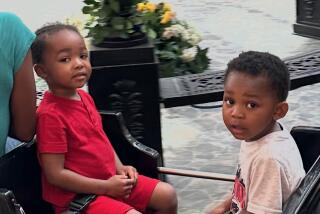Families of Twins Joined at Birth Help Each Other
- Share via
After Karen Crowe gave birth earlier this month to conjoined twins, the Loma Linda University Children’s Hospital began receiving flowers, cards and telephone messages from well-wishers who sympathized.
Only a few of the well-wishers, however, could actually empathize.
Through a fluke of nature, Crowe had become the newest member of one of the world’s rarest sororities of motherhood. About 50 pairs of conjoined twins--most now separated--currently live in the United States, based on the incidence and survival of such births, experts say.
Although there is no national registry listing these births and tracking their outcomes, an Arizona grandfather of conjoined twins has set up a support group for these families. He counts 27 of them as members of his 2-year-old organization.
They include an adult twin whose partner died as an infant and the parents of 11-month-old boys who cannot be separated because they share a heart.
They also include the parents of toddlers, adolescents and teenagers who were successfully separated shortly after birth and who are in virtually perfect health--and others still struggling, years later, with surgeries to mend bodies that were once as one.
No two cases of conjoined twins are the same, but of the various ways twins can generally be joined, Crowe’s children are among the more rare. They are joined side by side from the waist down, with only two legs.
But parents of all conjoined twins face many of the same challenges.
These parents know what it’s like for strangers to gape at their babies, to decide whether to attempt to separate the twins and to wonder what the future holds for children who may still face severe disabilities after such an operation.
Milly Cline of Chino, for example, talks of her doctor’s callousness in informing her that she was pregnant with twins, joined at the abdomen, who shared liver tissue.
“He suggested, very strongly, that they would be nonproductive vegetables,” she said.
Cline wouldn’t hear of it, and found a more supportive doctor who helped her come to peace with the pending birth.
Then, when she gave birth to April and Julie, 11 years ago in Los Angeles, she became “upset because the babies were such a curiosity factor at the hospital.”
Parents of other children in the hospital’s neonatal intensive care unit, Cline said, “were coming over and gawking at ours. We finally asked to have a partition put up in front of them so they wouldn’t be show and tell. “
The girls were separated three months later. Today, April is the artist, Julie the pianist, and nobody would know by looking at them that they had been joined at birth.
Since that time, Cline has sought to provide support to others in similar straits.
“There was nobody for me, at the time, to talk to,” Cline said of her 1987 experience. “I didn’t know anybody who had gone through what I was going through.”
In 1996, Cline drove to Loma Linda University Children’s Hospital, where Michelle Roderick had just given birth to twins also joined at the abdomen.
“She was like a bright star in the sky. She offered hope, because here was a family that had gone through what we were going through,” said Will L. Degeraty, Roderick’s father. “Until someone else reaches out to you, you think you’re the only one out there, and you can feel desperate.”
Inspired by the way Cline buoyed his daughter, Degeraty formed Conjoined Twins International later that year out of his home in Prescott, Ariz.
Until then, he said, parents of conjoined twins didn’t know how to contact others who had experienced the same thing, and felt isolated in their darkest fears and brightest hopes. Because there was no organization to motivate the parents of conjoined twins to reach out to support others, and because hospitals tend to protect the privacy of these families, the parents generally kept to themselves.
Degeraty said the parents of some conjoined twins have, for various reasons, eschewed contact with his group. Others have joined, saying they are willing to offer private support for new parents of conjoined twins--but want to avoid media interviews because they do not want to be swamped by publicity that might further stigmatize their children.
Among the members of the organization are parents of children who have been separated and are now leading virtually normal lives. Others--like Elaine and Scott Rainey of Fort Sam Houston, Texas-- have learned to cope with the challenges their children continue to face due to birth deformities.
Elaine Rainey gave birth in 1994 to Bethany and Hannah, who were joined from the stomach to the pelvis. They shared two good, strong legs--and a third, fused leg.
Rainey said she had never before heard the word “tripos;” now she knew what it meant.
Among her early anxieties, Elaine Rainey said, was how doctors defined “success” in the attempt to separate the girls. “In medical literature, ‘success’ was defined as one child surviving,” she said in a telephone interview. “We wanted to make sure the doctors were speaking the same language we were--that success meant we would have two living children.
“Early on, our motto became ‘Legs are cosmetic,’ ” she said. “We knew they could deal with that. We were worried about the life issues: Would they be healthy?”
Legs didn’t have anything to do with basic health. Because the middle leg had a large femur, it was divided between the girls, and the leg was amputated just above the knee. Prostheses were fitted for each girl. And sorry to have to be abrupt with the interview, Elaine Rainey said, but it was time to take the twins to gymnastics practice.
These might well be encouraging words for 21-year-old Karen Crowe of Barstow, whose newborns were delivered by caesarean section Feb. 10. The twins underwent surgery two days later to correct two problems, each of which could have been fatal.
Gabrielle had a blocked esophagus--which if uncorrected would have allowed stomach acids to be aspirated into her lungs, leading to pneumonia, and Micheala had a constricted artery that could eventually have led to heart failure. Both problems were addressed in four hours of surgery. On Monday, the girls were listed in fair condition.
Doctors say they hope to separate the girls, whose side-by-side, Y-shaped union presents a complicated medical challenge. The girls share one pair of legs, intestines and a single kidney and bladder--which would have to be somehow divided between them, and only one liver, requiring that one of the girls be placed on dialysis after separation until she could receive a liver transplant.
About one in 40,000 pregnancies involve conjoined twins; most are stillborn. Of the 1 in 200,000 live births, most die within hours of delivery, according to general statistics contained in medical literature. Among the few survivors, most will be separated--but then, one or both may die--weeks, months or years later, long after they have passed from public view. Very few twins who are not separated survive to adulthood.
Some parents speak not of the physical obstacles their children face, but of the strength they had to muster to cope with the future--after first coming to grips with the situation they found themselves in.
Take the Midwestern mother--who would only speak on condition of anonymity--who didn’t even know she was pregnant with twins joined at the lower abdomen until they were delivered.
“My husband said he never saw doctors break out in a sweat as fast as they did,” she said. “They were doing a [caesarean] section and when the first one didn’t come out, they knew there was a problem. They put her back in and somersaulted them out.
“At first, they wouldn’t tell me what the problem was--they couldn’t even tell if they were boys or girls,” she said. “Finally the doctors came over and said I had ‘Siamese twins.’ ”
The choice of slang disgusted her, she said; how dare the doctors refer to her children with a term assigned by P.T. Barnum to conjoined boys, born in Siam in 1811, who were later put on exhibit as a circus sideshow?
“I told them, you better come up with a better word than that, because it was so negative,” the mother recalled. “The next day, they called them ‘conjoined.’ ”
She said she felt overwhelmed fear, “because we didn’t know nearly as much then about conjoined twins as we do now.”
She and her husband, already a religious couple, turned to their faith for solace. “We knew God would give us the strength to deal with this,” she said. “I’m not saying there weren’t hard times, doubts, fears, but we knew that nothing comes to us unless it passes first through the hands of God. “
Twelve days after the birth, the girls were separated--but to this day they still have to undergo corrective surgeries.
“We’ve always told them,” the mother said of her two daughters, now teenagers, “that God made them special, and will use them in a mighty way in the future.”






